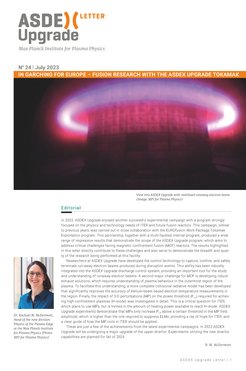New issue of the ASDEX Upgrade Letter published
Information about the fusion facility ASDEX Upgrade
In summer 2022, the last experimental campaign at the Garching fusion experiment ASDEX Upgrade came to an end before a two-year conversion of the facility began. The latest issue of the ASDEX Upgrade Letter now summarises important results that prepare the operation of the experimental facility ITER.

The main topics:
Studies for ELM free H-Mode access: Effect of magnetic perturbations on the L-H power threshold
Future fusion devices will have to avoid the peak power load to the first wall produced by edge localised modes (ELMs) in the high confinement (H-mode). To suppress ELMs in ITER, it is intended to use non-axisymmetric magnetic perturbation (MP) fields from external coils. Experiments on other fusion devices have shown that the application of MPs can increase the required heating power to access H-mode (L-H power threshold). The recent analysis at ASDEX Upgrade suggests that there is a window in which ELM suppression is possible without increasing the L-H power threshold.
Advanced control: Runaway electron studies in support of ITER
Tokamak operation requires active feedback control to achieve a sustained stable discharge. If the control is lost, the discharge will terminate abruptly with a disruption. During such a disruption the device experiences both high thermal and structural loads. For larger devices such as JET and especially ITER, another phenomenon is a significant issue. This is the generation of runaway electrons during the disruptions. The article in the new issue describes experiments with runaway electrons at ASDEX Upgrade, which provide clues as to how this undesirable phenomenon in plasmas could be terminated without damaging fusion devices.
Improved edge profile accuracy: New model for the helium beam diagnostics
The thermal helium beam at ASDEX Upgrade is an emission spectroscopy based diagnostic used to understand the edge plasma of fusion experiments. Neutral particles (here thermal helium) are locally injected into the plasma vessel. By the interaction with the plasma, atomic transitions are excited, leading to measurable radiances that are detected by an optical system. Collisional radiative models are used to calculate the interaction between the neutral injected atoms and the plasma. Now a new model has been developed at ASDEX Upgrade. With this, even more accurate temperature and density profiles can be calculated.
Check out the latest issue of the ASDEX Upgrade Letter.
